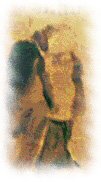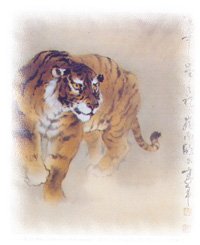Visual Arts -- Painting
Paintings made before the Tang dynasty (618-907 A.D.) were mainly line drawings of people; this was the golden age of human figure drawing. By the mid-Tang dynasty, many landscape and flower-and-bird paintings began to appear.

Sung dynasty painter Liang K'ai. |
The upper classes of the Tang and Sung (960-1279 A.D.) dynasties were major supporters of Chinese painting. The works of this period tended to be more serious and to have a more political and educational significance, and they were also more elaborate and extravagant in style. Because the Sung dynasty court established a systematized academy of painting, granted patronage to painters in the academy, and sponsored the training of promising painters, the academy of painting reached the zenith of its activity during this period.
As the times changed due social, economic, and cultural influences, an increasing number of literati began to paint, and literature came to have an ever-expanding influence on painting. By 11th century A.D., the school of "literati painting" had already emerged. And by the Mongol Yuan dynasty (1271-1368 A.D.), a formal painting academy within the imperial palace no longer existed, so the court style of painting declined. At this point, the "literati" school of painting became mainstream, and the literati painters guided the direction of painting.
Literati prefer to paint without restriction, and they are fond of subject matter such as mountains and rocks, clouds and water, flowers and trees, and the "four gentlemen" (plum blossoms, orchids, bamboo, and chrysanthemums). Because natural objects are easier subjects to paint than the human figure, the painter can better use the brush and ink's potential for free expression.
Whether chinese painting is "realistic" is the object of frequent debate. Realism in Chinese painting reached its climax in the painting of the Tang and Sung dynasties. However, the kind of "realism" used in Chinese painting is not an objective perception through the sense of sight but rather a subjective expression of recognition or insight. For instance, a Sung dynasty painter used watercolor wash techniques to achieve an effect of light and dark, which represented the forces of "yin" and "yang", to express his grasp of the eternal and most characteristic nature of his human subject.

|
Beginning in the Sung dynasty, a small number of artists began to write the names of the giver and recipient of the painting, or to stamp their name chop, in a corner of the work. When "literati" painting was in vogue, painters began adding personal notes, or related lines of poetry, to display their prose and calligraphic skill. Thus, writing on paintings was given a more prominent place on the work. This caused a union of signature, names of giver and receiver, and notes on the painting or related verse, with the painting itself. The stamping of name chops also became established at this time, and the addition of name chop impressions, an art in itself, further enriched Chinese painting.



 Chinese Culture
Chinese Culture